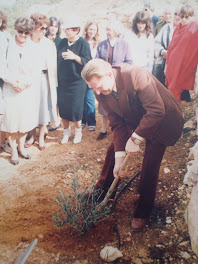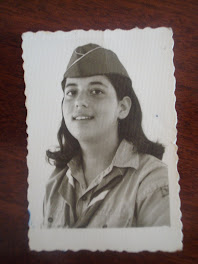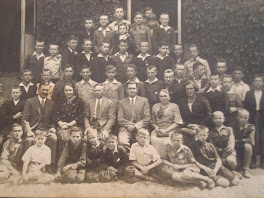Description of I Remember
In order to understand the movie’s intentions it is essential that a detailed description of I Remember be given. The film is approximately an hour in length and solely uses black and white film. As noted before, the structure of the film revolves around four survivors’ testimonies. All of them are male and visually appear to be at least sixty-five to seventy years in age. No commentary, archival photographs or film is used. Instead the film is interlaced with footage of teenagers participating on the program “March of the Living.” “March of the Living” is an international program that brings Jewish teenagers to Poland every year on Yom Ha-Shoah, Holocaust Remembrance Day, to march from Auschwitz to Birkenau.[6] Throughout the film, as the survivors are telling their story, the camera fades from the image of the survivor to an image of a participant on “March of the Living.” Through this technique a deeper sense of story and attachment is created in reference to the aging survivor, although no other visual reference is made to his past.
The introduction to the film is approximately a minute and thirty seconds. The opening credits are very plain, white typeface on a black background. They first introduce the film as a product of Steven Spielberg and the Survivors of the Shoah Visual History Foundation and then clearly introduce Wajda’s connection to the film. The opening scene is of a group of young adults walking around the concentration camp Auschwitz while deeply contemplating and thinking. They look extremely sad and reflective. During this scene classical music is played that further invokes feelings of sorrow. The four survivors are introduced and each one briefly talks about a seemingly happy and carefree aspect of their life before the war. One of the survivors even mentions, “When I look back on it now it seems like it was a very fun time.”[7] The introduction ends with a shot of the “March of the Living” participants walking under the sign “Arbeit Macht Frei,” which translates to “Work Makes You Free,” at the entrance of the former Auschwitz concentration camp.
The film is divided into four sections; each survivor gives his testimony in full, one after the other. The first survivor to give his testimony, Leszek Allerhand, currently lives in Zakopane and is one of the few Jews who remain in Poland today. He is a gentle looking man with thin, soft, white hair. He is wearing a dark turtleneck shirt with a dark blazer and is very unimposing. Throughout his testimony a special effort is made to connect the image of his face with the face of one particular young man participating on “March of the Living.” The video of Leszek’s testimony continually transitions to momentary images of this boy. In general, Leszek’s testimony seems to focus on the universality of feelings. Leszek tells the story of how in the ghetto he fell in love with a girl, but she was hanged. As he tells this story fleeting images of a young woman, presumably the age his girlfriend was, are shown. This technique is used to make the story more relatable to a much younger generation and therefore more impacting. While talking about the loss of his girlfriend Leszek says, “Ghetto or no ghetto, Jew or non-Jew, love, feelings, desire – it’s all the same.”
Leszek then continues to tell the story of how he escaped from the ghetto with his mother and hid with his “aunt,” who was not Jewish, but actually a prostitute for the Germans. Ironically he said that hiding under her bed was the “safest place in the world,” but he was forced to leave after a German reported that his “aunt” had a venereal disease.
Interestingly, when describing himself as a child, Leszek refers to himself as “a kind of Jewish monster.” He describes himself as having “red hair, pale, skinny with frightening eyes and a long nose,” a stereotype of Jews that still remains today. He mentions this because when he left his “aunt” and was trying to hide in the non-Jewish outside world there was an instance where “Polish thugs” called him “Jew Boy” and enthusiastically turned him over to the German officers while a crowd of aggressive spectators formed around him. With luck, he and his mother were able to escape before entering the concentration camps because the group of Jews and German soldiers he was traveling with were dying and his mother was finally able to bribe the remaining German officer with her wedding ring. Having nowhere to go, they then went to the Korczak cemetery and literally hid in the graves. Leszek ends his testimony by stating “every day was a victory of survival.” His testimony ends with footage from “March of the Living” and with shrill and intense music that invokes a sense of fear.
The next survivor to speak is Stanislaw Jonas, a slightly more formal looking bald man who now lives in New York. Stanislaw’s story begins when his family escaped from an Aktion, an assembly and deportation of Jews to the concentration camps, with the help of a Jewish police officer. He speaks about how while in the ghetto all one thought about was escaping to the other side, but once outside life was even more dangerous. He says, “The worst killers in the ghetto were hunger and disease. On the Aryan side it wasn’t hunger or disease, but the people themselves.”
The family that Stanislaw and his family lived with did not know that they were Jewish, but when they found out, Stanislaw was forced to leave. Stanislaw in particular had a hard time hiding his identity because he would frequently hum Jewish songs that he learned in the ghetto. Stanislaw does not seem to have negative feelings towards the woman who forced him to leave after his identity was revealed. Instead he says understandably “she was a very decent woman, nevertheless, she was scared. So we had to leave.”
Throughout Stanislaw’s story there is a constant pattern where he hid with families who he believed cared about his well being, but ultimately, when danger increased, he was forced to leave the relative safety of these homes. A particularly emotional part of his testimony occurs when he speaks about overhearing Poles discuss that the Jews were being burned and that this was a good thing. When he repeated this to one of the Polish women he was staying with, she scolded him. At this point in the testimony, Stanislaw looks extremely sad and as if he is trying hard to hold back tears and it takes him a moment to recover from what he has just said. Stanislaw talks about how his time in hiding “was a time of intense religious feeling for me.” He was praying a lot then, not only to God, but also to Jesus. He closes by relaying the impact from his trauma of hiding. Even today, while living in America, if someone asks him whether he is a Jew, he sometimes says no.
Stanislaw’s testimony is especially powerful because of the emotion he conveys while speaking. It is difficult to watch such a formal looking man struggle so much while telling his story. Several times throughout his testimony Stanislaw must pause to collect himself before continuing. In addition, the same techniques used in the previous testimony are applied here, such as the inclusion of momentary clips of young adults and the use of powerful music.
The third survivor, David Efrati from Israel, presents a less formal air than Stanislaw. Immediately he begins using gestures and sound effects to aid the telling of his story. What is immediately noticeable from David’s testimony is how distinctly different he views himself from the Poles. When talking about Poles he continually refers to them by using the pronoun “they” and he mentions “I met a lot of Poles.” It is interesting that the Poles David keeps mentioning with distancing terms are actually many of the parents and grandparents of the Polish people viewing this film.
David’s testimony talks a lot about images of Poles, Jews, and Germans. He mentions that at one particular instance while hiding during the Holocaust he heard someone crying, but was not afraid “because a German doesn’t cry. Only a Jew cries.”His opinion towards the Poles is that the majority of them were apathetic, though there were some who were good and some who were bad.
Luckily, David encountered what he considered were good Poles. When looking for a place to hide, David ran to the house of his good Polish friend, Stasiek. Not only did Stasiek’s family take him in to their house, clean him and feed him, Stasiek’s father was hiding other Jews in a basement down the street. Sadly these Jews were discovered. Unfortunately, before they were killed the Jews informed the German authorities that Stasiek’s father was responsible for hiding them and so his father was killed as well. Despite all of this Stasiek did not throw David out. Eventually David chose to leave Stasiek’s house, but not because Stasiek forced him to.
David was fortunate to have had several positive encounters with Poles. After leaving Stasiek’s house he came in contact with a Polish woman who was especially kind to him. David dramatically managed to escape from a cattle car traveling to Treblinka before returning to the safety of Stasiek once more.
The final person on the film to give a testimony is Henryk Mandelbaum, a sweet and gentle looking man now living in Gliwice. It is almost impossible to believe that this old man was once a member of the Sonderkommando, a group of men who were forced to dispose of corpses at the gas chambers, at Auschwitz. He continually refers to his time in Auschwitz as “a real hell.” He gives detailed descriptions of how the Jews were tricked into entering the gas chambers, the killing process, and his role within the gas chambers. He also refers to the notorious rebellion of the Sonderkommando at the crematorium at Auschwitz. After the rebellion was subdued all of the Sonderkommando, including himself, were lined up and every third person was shot.
Besides the detail given to the description of his experiences in the crematorium, it is interesting how Henryk seems to mentally separate himself from the Jews and victims who were killed before him every day. Perhaps as a protection device, when talking about the Jews who were taken to the gas chambers, he refers to them as “they” and “these.” He says, “They were tired and so mistreated.” There is a deep sense of distinction between himself and these Jews, as if they were on two different levels. A sense of guilt is also inferred when Henryk mentions that he could not give them any advice that would help them escape from this hell. Clearly he is still dealing with the moral implications that came from the actions he was forced to perform.
The film concludes similarly to how it began, with images of the four survivors and the participants from “March of the Living,” while classical music is being played. An interesting and important addition though are images of Pope John Paul II looking emotionally distressed and of him at the Western Wall in Jerusalem. The film ends with a brief description of “March of the Living.”
In a press statement concerning the release of I Remember the Shoah Foundation states Wajda’s intention for the film:
He cut original footage of the famous “March of the Living” throughout the film as a symbol of hope and improved dialogue between young Jews, Poles, and Germans. Also included are clips of Pope John Paul II praying at the Western Wall in Jerusalem to underscore the director’s statement that “The film focuses on the dramatic and specific relations between Jews and Poles in Nazi-occupied Poland. An emotional story of a few people, whose experiences describe the facts, as well as the atmosphere and spirit of what happened.”
Based on this statement it is clear that Wajda, and those who contributed to the film, considered the issues that need to be confronted when creating the film. However, whether they confronted these issues strongly enough is up to individual interpretation.
text from : http://www.history.ucsb.edu/faculty/marcuse/classes/133q/samplepapers/ShoahFdnPolandRbinning05z.htm















